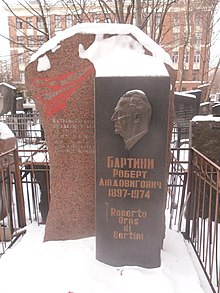Robert Lyudwigowitsch Bartini
Robert Lyudwigowitsch Bartini ( Russian Роберт Людвигович Бартини ; originally Roberto Oros di Bartini ) (born May 14, 1897 in Fiume (now Rijeka ), † December 6, 1974 in Moscow ) was a Soviet aircraft designer of Italian descent.
Life
Bartini's mother, who was unknown to him, died shortly after his birth and the child was taken care of by his relatives in a farming family. At the age of three it was adopted by the Lieutenant Governor of Fiume, Baron Lodovico Oros di Bartini, and his wife as an adopted son. While attending a military school, Bartini came to the Eastern Front as an officer candidate during World War I , where the 19-year-old was captured during a Russian offensive in June 1916 and interned in a camp near Khabarovsk . In 1920 Bartini returned to his homeland after being released from captivity and went to Rome the following year to attend a flight school. During his stay in the camp, Bartini came into contact with Bolshevik ideas and during his stay in the Italian capital, he joined the Communist Party of Italy (PCI) as a result in 1921 . In 1922 he moved to Milan and began studying aircraft construction at the local polytechnic , which he had to break off after Mussolini's march on Rome in October of the same year.
After the fascists had taken power in Italy in 1923, he fled to the Soviet Union by decision of the PCI , where he changed his name to Robert Lyudwigowitsch Bartini and in September took on Soviet citizenship. Initially, Bartini got a job at Moscow Airport , but on the instructions of the head of the Research Institute of the Air Force Gorshkov on October 10th, he moved to his technical department, where he was responsible for the introduction of the IL-400B fighter into the troops. Next, he accompanied the production of the German bomber plane JuG-1 , which was built in Fili , for which he was promoted to chief engineer. From 1928 he worked on the design of the ROM-1 flying boat developed under the leadership of Dmitri Grigorowitsch in the OPO-3 department , during which Bartini met Sergei Ilyushin , who was active in the scientific and technical committee of the air force at the time and commissioned him to prepare the planned long-haul flight of the ANT-4 Strana Sovietov from Moscow to New York. After its successful implementation, Bartini returned to the OPO-3 and in 1929 developed the double-hull reconnaissance flying boat ANT-22 . In 1930 he was appointed chief designer of the OPO-3, but after severe criticism when it was taken over by another department in the same year, he was released from his duties as a designer of military aircraft.
Bartini then moved to the Research Institute of the Civil Air Fleet, where he got a job as chief designer at Plant No. 240 in Novosibirsk on the intervention of Pyotr Baranov . It was there in 1933 that the Stal-6 experimental aircraft , which was designed for high speeds and reached 420 km / h, was built. The following year the DAR flying boat was created . As a rival design to the PS-35 airliner , Bartini and his design team designed the all-metal Stal-7 airliner in 1937 , which passed some very successful long -range flight tests and later served as the basis for the construction of the long-range bomber Jer-2 .
Bartini was no longer personally involved in the construction of the bomber because he was arrested in 1938 and sentenced to ten years in a labor camp on charges of espionage for Fascist Italy. Subsequently, he was assigned to the design office 29, in which other imprisoned designers such as Andrei Tupolew and Dmitri Tomaschewitsch worked. Bartini was dismissed in 1947; but his rehabilitation from all accusations did not take place until 1956, three years after Stalin's death . Then he worked again on the development of new types of aircraft, initially in Georgi Beriev's development office ( OKB-86 ) in Taganrog . In 1952 he came again to Novosibirsk, where he took over a department in the Aeronautical Research Institute. There the project of the supersonic bomb plane T-203 arose, which after Bartini's move to OKB-256 in 1956 by Pawel Zybin as A-57 was pursued, but not realized. Zybin's development office was closed in 1959 and Bartini returned to Beriev in Taganrog, where the final high point of his work was the large amphibium WWA-14 , which first flew in 1972.
Bartini was a member of the Presidium of the All Union Council for Aerodynamics, in whose function he wrote numerous papers on technical topics, but also on the fundamentals of physics and elementary particles, between 1932 and 1935. Many of his handwritten notes have so far been unpublished at his testamentary request. After his death, Bartini was buried in the Vvedenskoye cemetery .
See also
- (4982) Bartini , asteroid of the main belt
- Bartini Stal-6
- Bartini Stal-7
- Bartini DAR
- Bartini A-57
- Bartini T-117
- Bartini-Beriev WWA-14
literature
- Horst Materna: An aristocrat as a designer in the USSR: VTOL-Amphibium WWA-14 . In: FLiEGERREVUE X . No. 64 , p. 76-89 .
Web links
- A57 design by Bartini (excerpt from the series Planes That Never Flew )
- Technical details of the A-57 bomber
| personal data | |
|---|---|
| SURNAME | Bartini, Robert Lyudwigowitsch |
| ALTERNATIVE NAMES | Bartini, Roberto Oros di |
| BRIEF DESCRIPTION | Soviet-Italian aircraft designer |
| DATE OF BIRTH | May 14, 1897 |
| PLACE OF BIRTH | Fiume |
| DATE OF DEATH | December 6, 1974 |
| Place of death | Moscow |
